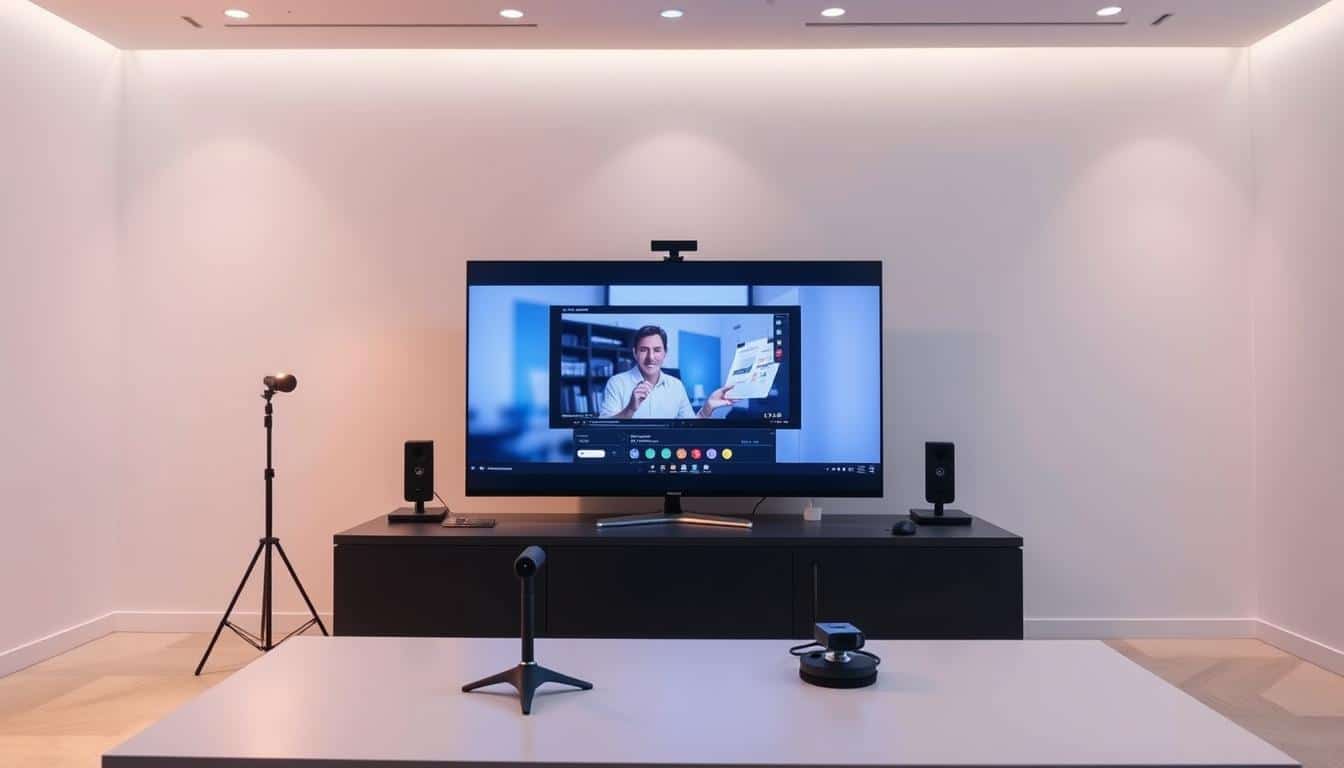Anúncios
In today’s world, the right camera angles for video calls are super important. More companies are using video conferencing. So, knowing where to place your webcam is key to look your best and connect well with people online. This piece will give you tips to boost your video presence, making sure you come across as confident and engaging.
Studies suggest that putting the webcam a bit above your eyes looks best. This angle helps you avoid looking like you have a double chin. Being an arm’s length away from the camera makes you look clear and friendly. We’re going to cover how to find these perfect angles. Plus, give you advice to stand out in online meetings.
Anúncios
Understanding the Importance of Camera Angles
Camera angles are key to looking professional on video calls. How you set up your camera affects how others see your expertise and leadership. Picking the right angle can make everyone feel more connected and interested during the call. Different angles can change how people engage with what you’re sharing.
Impact on Professionalism
It’s important to keep your camera at eye level for a professional look. This position makes you seem more relatable, making your talks feel real. However, low angles might make you seem too bold or hard to approach. A good camera set-up avoids angles that can make you look bad, like being too low or high, which can hurt how credible you look.
Anúncios
Enhancing Viewer Engagement
To keep viewers interested, think about where your camera is pointing. Having it at eye level makes it easier for people to pay attention. Close-up shots can show off emotions and details, making your call more engaging. Meanwhile, mid-range shots are good for not overwhelming your audience with too much detail. Mixing these approaches helps make your video calls better.
Why Eye-Level Positioning is Crucial
Having your webcam at eye level is very important. It makes you look professional and keeps viewers interested. It feels like you’re making real eye contact, which makes talks seem more real and friendly. If the camera is too high or too low, it can make things look weird. This can make it hard to understand each other during chats.
Promoting Natural Eye Contact
Eye contact is super important in video meetings. It helps people feel connected. If the webcam is set up right, everyone can talk more clearly. The camera should be at the same height as your eyes when you’re sitting. This is usually about 42 to 52 inches off the ground. This setup is just like talking to someone in person, making everything better.
Eliminating Unflattering Perspectives
The angle of your camera really matters in video calls. If it’s too low, you might seem too strong or even angry. And if it’s too high, it looks like you’re not really there. You want to find a middle ground. This helps everyone talk confidently and respectfully. Putting your webcam in the right spot keeps the weird angles away. This way, you look good and professional.
How to Achieve Optimal Camera Angles for Video Conferences
To get the best camera angles for video conferencing, you need good placement and the right tools. Proper positioning can make you look professional and improve the experience for everyone watching. Try to keep the camera at eye level or a bit higher for the most flattering look.
Placement Techniques for Your Webcam
Here are some tips for placing your webcam well:
- Put your webcam just above eye level for the perfect angle.
- Tilt the camera down a bit to show your best side.
- Keep the webcam no higher than your hairline to stay in the right spot.
- Don’t put the camera too low or too high to keep your face looking right.
- Make sure the camera is 2-3 feet away to frame yourself properly without too much space above your head.
Using Adjustable Mounts and Stands
Adjustable mounts and stands can make it easier to position your camera well. Here are some ideas:
- Get adjustable webcam mounts to keep your camera where you want it.
- If you don’t have a stand, try stacking books or a box to lift your camera.
- Check out advanced cameras like PTZ or dual-lens models for better framing. For example, the Yealink UVC84-BYOD Kit is great for different settings.
- For big rooms, look into systems that combine wide-angle and zoom cameras for better coverage.
Lighting and Its Role in Video Conferencing
Lighting is key in video conferencing, making communication better. It improves video quality and helps keep viewers interested. Using both natural and artificial light is the best way to get clear visibility.
Choosing the Right Light Sources
Natural light is perfect, especially when used the right way. Face a window to make the most of daylight. For artificial lighting, ring lights or softboxes help keep your video clear. Pick lights that mimic daylight with a color temperature of around 6000K, as they create a welcoming space. It’s also important to choose lights with a high Color Rendering Index (CRI) to make sure your colors look true.
Best Practices for Lighting Placement
How you set up your lights can change how your video calls look. Don’t put a light behind you because it causes bad shadows or too-bright backgrounds. Instead, put your main light in front or at a 45-degree angle. This reduces shadows and lights your face evenly.
If you want a better setup, try using a two-point lighting system. Use a key light and a fill light to add depth. Adding a backlight in a three-point setup helps you stand out from the background.
Camera Composition: Framing Your Shot
Camera composition is key in improving your video conferences. Use the rule of thirds to frame your shot nicely. Make sure your background is clear and tidy, making your video calls look professional.
Following the Rule of Thirds
The rule of thirds splits your shot into nine parts using lines. Place important parts, like your face, at the line intersections to look good. This makes your video engaging, especially in conferences. Try using different shot types, like close-ups, to make it look better.
Ensuring a Clear Background
Choosing the right background makes a big difference in your call. A clutter-free backdrop keeps the focus on you. Use neutral colors or a simple space to avoid distractions. You can add personal or work items, but make sure they don’t take over.
Camera Angles for Video Conferences: Expert Tips
Knowing the right camera angles is key to better video calls. Many people make webcam mistakes like bad positioning. By following expert advice, you can look more professional and keep your audience interested.
Common Mistakes to Avoid
- Placing your camera too low or too high can distort your appearance.
- Failing to position the camera at eye level may hinder natural eye contact.
- Inadequate lighting leads to shadows and unprofessional looks.
- Using a narrow-angle lens in small rooms can result in a cramped view.
Examples of Effective Angles
For a good on-camera appearance, try these tips:
- Use wide-angle lenses in small rooms to show more space.
- Make sure your camera is at eye level, even if you need to prop it up.
- Tilt the camera down slightly to keep your eyes in the frame’s top third.
- Use soft, diffused lighting to illuminate your face without creating shadows.
Putting your video window at the top of the screen makes it seem like you’re making eye contact. Use adjustable mounts for the best camera angle and avoid awkward setups. For big meetings, multi-camera systems with wide views and zoom keep the quality high.

Using Technology to Enhance Camera Angles
Using new technology helps us get the best camera angles for video meetings. Webcam software lets us adjust camera positions and zoom without touching anything. For big gatherings, using many cameras helps show different views. This keeps everyone interested.
Webcam Positioning Software
Webcam software is key to better video quality. It can automatically keep you in the center of the frame. AI makes this even better by adjusting focus and framing so everyone looks great.
Multi-Camera Systems for Large Conferences
For big conferences, multi-camera setups are great. They can move in all directions and zoom in precisely. Using wide lenses lets more people fit in the view.
Systems that track who’s speaking focus on them using face and voice recognition. This keeps meetings lively. Adding AI for clear videos in 4K and adjusting lighting helps everyone see clearly.
The Influence of Webcam Types on Angles
The webcam you pick greatly affects your video conference appearances. Different types, especially wide-angle webcams, change how you’re seen and keep viewers interested. Knowing these differences helps you choose the right webcam for video meetings.
Wide-Angle vs. Narrow Lens Options
Choosing a webcam means looking at the field of view (FOV). The FOV can be from 60° to 360°. Wide angles capture a bigger area, perfect for small spaces with many people. But, narrow lenses work best in big rooms where focus and detail matter more.
Choosing the Right Webcam for Your Space
Think about room size and furniture layout when picking a webcam. Some webcams have fixed angles for consistent views. Others offer flexible angles for adjusting to who’s speaking. Auto-framing and speaker tracking features keep everyone clearly visible, adjusting as the conversation moves.
Considering these points helps you pick the best webcam for your needs. This makes video chats much better.
Common Challenges with Camera Angles
When on video calls, people often face camera challenges that affect their communication. Distorted video can make images look bad and distract viewers. Solving these issues can make the video better for everyone.
Addressing Distortion Issues
Wide-angle lenses can cause distortion if the camera is too close. This makes the speaker look less professional. To avoid this, keep the camera at a good distance. Use things like an adjustable stand, books, or a mini tripod for the best angle. Setting the camera at eye level helps with lighting and looks more flattering.
Managing Background Distractions
A messy background can take attention away from the speaker. Choosing a simple background helps people focus on you. You can use virtual backgrounds to hide distractions. Advanced tech can even keep you in the center of the frame automatically.
Conclusion
The right camera angles make a big difference in video conferencing. They help you look more professional and keep viewers interested. We’ve looked at the best ways to pick camera angles, like keeping the camera at eye level. It’s also key to have a background that’s neat and doesn’t distract.
Using top-notch cameras, like those from AVer, helps too. They work well in both small and big rooms, making your presentations stand out. Good video and sound quality, along with the right setup and lighting, improve how you come across online during meetings.
By using what you’ve learned in this article, your video meetings will get better. You’ll seem more professional and make a stronger impact. Choosing the correct camera angles is crucial for effective video conferencing. It makes virtual talks feel more like real, face-to-face conversations.



